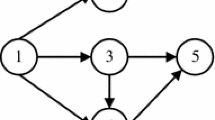Abstract
The identification of critical network components is of interest to both interdictors wishing to degrade the network’s performance, and to defenders aiming to preserve network performance in the face of disruption. In this study, novel formulations for the defender’s problem, based on the dual to the multi-commodity flow problem, are developed to solve the critical node problem (CNP), in which the nodes can be disabled, for a variety of commonly-studied objectives, including minimum connectivity, cardinality-constraint CNP, and β-disruptor problem. These objectives have applications in many types of networks, including transportation, communications, public health, and terrorism. Extensive computational experiments are presented, demonstrating that the proposed models dramatically reduce the computational time needed to solve such problems when compared to the best-performing models in the current literature. The proposed CNP models perform particularly well for networks that are originally disconnected (before interdiction) and for networks with a large number of two-degree nodes.


Similar content being viewed by others
References
Albert R, Jeong H, Barabási AL (2000) Error and attack tolerance of complex networks. Nature 406(6794):378–382
Albert R, Albert I, Nakarado GL (2004) Structural vulnerability of the north American power grid. Phys Rev E 69(2):025103
Arulselvan A, Commander CW, Elefteriadou L, Pardalos PM (2009) Detecting critical nodes in sparse graphs. Comput Oper Res 36(7):2193–2200
Arulselvan A, Commander CW, Shylo O, Pardalos PM (2011) Cardinality-constrained critical node detection problem. In performance models and risk management in communications systems. Springer, New York, pp 79–91
Batagelj V, Adrej M (2006) Pajek dataset. URL: http://vlado.fmf.uni-lj.si/pub/networks/data/bio/foodweb/foodweb.htm. Accessed 23 June 2016
Bavelas A (1948) A mathematical model for group structure. Appl Anthropol 7:16–30
Boginski V, Commander CW (2009) Identifying critical nodes in protein–protein interaction networks. Cluster Chall Biol Netw:153–167
Brown G, Carlyle M, Diehl D, Kline J, Wood K (2005) A two-sided optimization for theater ballistic missile defense. Oper Res 53(5):745–763
Cantillo V, Macea LF, Jaller M (2018) Assessing vulnerability of transportation networks for disaster response operations. Netw Spat Econ:1–31
Cappanera P, Scaparra MP (2011) Optimal allocation of protective resources in shortest-path networks. Transp Sci 45(1):64–80
Commander CW, Pardalos PM, Ryabchenko V, Uryasev S, Zrazhevsky G (2007) The wireless network jamming problem. J Comb Optim 14(4):481–498
Darayi M, Barker K, Santos JR (2017) Component importance measures for multi-industry vulnerability of a freight transportation network. Netw Spat Econ 17(4):1111–1136
Davis TA, Hu Y (2011) The University of Florida sparse matrix collection. ACM Trans Math Softw (TOMS) 38(1):1
Dinh TN, Thai MT (2011) Precise structural vulnerability assessment via mathematical programming. In 2011-MILCOM 2011 Military Communications Conference, IEEE. 1351–1356
Dinh TN, Thai MT (2015) Network under joint node and link attacks: vulnerability assessment methods and analysis. IEEE/ACM Trans Networking 23(3):1001–1011
Dinh TN, Xuan Y, Thai MT, Park E, Znati T (2010) On approximation of new optimization methods for assessing network vulnerability. In: 2010 Proceedings IEEE INFOCOM, IEEE. 1–9
Dinh TN, Xuan Y, Thai MT, Pardalos PM, Znati T (2012) On new approaches of assessing network vulnerability: hardness and approximation. IEEE/ACM Trans Networking 20(2):609–619
Elefteriadou L (2004) Highway capacity. In: Kutz M, editor. Handbook of transportation engineering. New York: McGraw-Hill; 2004; p. 8–1–8-17 (chapter 8)
Ferris MC, Meeraus A, Rutherford TF (1999) Computing Wardropian equilibria in a complementarity framework. Optim Methods Softw 10(5):669–685
Freeman LC (1979) Centrality in social networks I: conceptual clarification. Soc Networks 1:215–239
Gomes T, Tapolcai J, Esposito C, Hutchison D, Kuipers F, Rak J, de Sousa A, Iossifides A, Travanca R, Andre J, Jorge L, Martins L, Ortiz Ugalde P, Pasic A, Pezaros D, Jouet S, Secci S, Tornatore M (2016) A survey of strategies for communication networks to protect against large-scale natural disasters. 8th International Workshop on Resilient Networks Design and Modeling (RNDM), Halmstad. 11–22
Gourdin E, Omic J, Van Mieghem P (2011) Optimization of network protection against virus spread. In Design of Reliable Communication Networks (DRCN), 2011 8th international workshop. IEEE:86–93
Granata D, Steeger G, Rebennack S (2013) Network interdiction via a critical disruption path: branch-and-price algorithms. Comput Oper Res 40(11):2689–2702
Karakose G, McGarvey RG (2018) Node-securing connectivity-based model to reduce infection spread in contaminated networks. Comput Ind Eng 115:512–519
Krebs V (2002) Uncloaking terrorist networks. First Monday 7(4)
Kuhnle A, Nguyen NP, Dinh TN, Thai MT (2017) Vulnerability of clustering under node failure in complex networks. Soc Netw Anal Min 7(8)
Lusseau D, Schneider K, Boisseau OJ, Haase P, Slooten E, Dawson SM (2003) The bottlenose dolphin community of doubtful sound features a large proportion of long-lasting associations. Behav Ecol Sociobiol 54(4):396–405
Matisziw TC, Murray AT (2009) Modeling s–t path availability to support disaster vulnerability assessment of network infrastructure. Comput Oper Res 36(1):16–26
Matisziw TC, Murray AT, Grubesic TH (2007) Bounding network interdiction vulnerability through Cutsest identification. In: Murray AT, Grubesic TH (eds) Critical infrastructure: reliability and vulnerability. Springer-Verlag, Berlin, pp 243–256
Matisziw TC, Murray AT, Grubesic TH (2010) Strategic network restoration. Netw Spat Econ 10(3):345–361
Medlock J, Galvani AP (2009) Optimizing influenza vaccine distribution. Science 325(5948):1705–1708
Murray AT, Matisziw TC, Grubesic TH (2007) Critical network infrastructure analysis: interdiction and system flow. J Geogr Syst 9(2):103–117
Murray-Tuite P, Mahmassani H (2004) Methodology for determining vulnerable links in a transportation network. Trans Res Record: J Trans Res Board 1882:88–96
Myung YS, Kim HJ (2004) A cutting plane algorithm for computing k-edge survivability of a network. Eur J Oper Res 156(3):579–589
Nerlich B, Koteyko N (2012) Crying wolf? Biosecurity and metacommunication in the context of the 2009 swine flu pandemic. Health Place 18(4):710–717
Pullan W (2015) Heuristic identification of critical nodes in sparse real-world graphs. J Heuristics 21(5):577–598
Shen S, Smith JC (2012) Polynomial-time algorithms for solving a class of critical node problems on trees and series-parallel graphs. Networks 60(2):103–519
Shen S, Smith JC, Goli R (2012) Exact interdiction models and algorithms for disconnecting networks via node deletions. Disc Optim 9:172–188
Di Summa M, Grosso A, Locatelli M (2012) Branch and cut algorithms for detecting critical nodes in undirected graphs. Comput Optim Appl 53(3):649–680
Sun X, Wandelt S, Cao X (2017) On node criticality in air transportation networks. Netw Spat Econ 17(3):737–761
Thiery A (2010) https://linbaba.wordpress.com/2010/10/ , Accessed 7 July 2017
Veremyev A, Prokopyev OA, Pasiliao EL (2014a) An integer programming framework for critical elements detection in graphs. J Comb Optim 28(1):233–273
Veremyev A, Boginski V, Pasiliao EL (2014b) Exact identification of critical nodes in sparse networks via new compact formulations. Optim Lett 8(4):1245–1259
Veremyev A, Prokopyev OA, Pasiliao EL (2015) Critical nodes for distance-based connectivity and related problems in graphs. Networks 66(3):170–195
Wood RK (1993) Deterministic network interdiction. Math Comput Model 17(2):1–8
Yan G, Eidenbenz S, Thulasidasan S, Datta P, Ramaswamy V (2010) Criticality analysis of internet infrastructure. Comput Netw 54(7):1169–1182
Zachary WW (1977) An information flow model for conflict and fission in small groups. J Anthropol Res:452–473
Zhou T, Fu ZQ, Wang BH (2006) Epidemic dynamics on complex networks. Prog Nat Sci 16:452–457
Author information
Authors and Affiliations
Corresponding author
Rights and permissions
About this article
Cite this article
Karakose, G., McGarvey, R.G. Optimal Detection of Critical Nodes: Improvements to Model Structure and Performance. Netw Spat Econ 19, 1–26 (2019). https://doi.org/10.1007/s11067-018-9407-0
Published:
Issue Date:
DOI: https://doi.org/10.1007/s11067-018-9407-0




